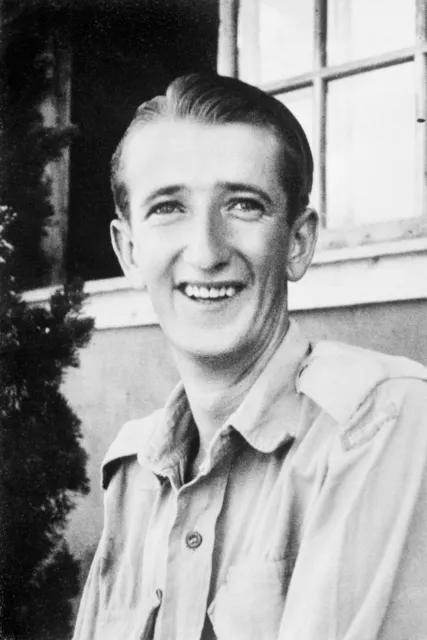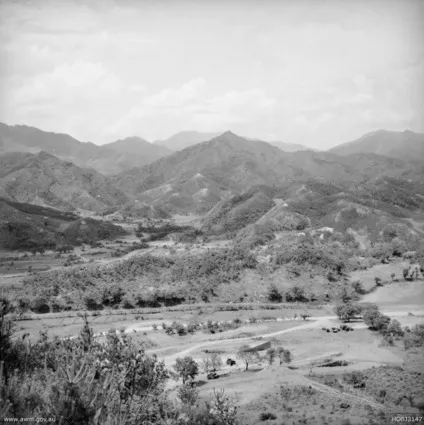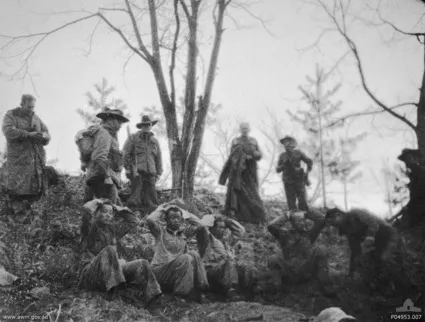 Horace Madden, 1947
Horace Madden, 1947
Madden was initially posted to the 114th Australian General Hospital in Goulburn, New South Wales.[1] As part of the CMF, he was not required to serve outside of Australia or its territories, but despite this he transferred to the Australian Imperial Force in August 1943. Nicknamed 'Slim' due to his lean build, Madden saw service with the 8th Field Ambulance in New Guinea, during which he contracted malaria.[2] He later served with the 5th Motor Ambulance Convoy Platoon on Bougainville and was part of the British Commonwealth Occupation Force in Japan after the war. He was eventually discharged from the army in June 1947.[1]
After leaving the army, Madden took up work at a mental hospital. Two months after the Korean War broke out, he reenlisted with the Australian Army for service as a private in Korea. Initially assigned to 3rd Battalion, Royal Australian Regiment (3 RAR) for duty as a driver, he later volunteered for signalling duties.[1]
In April 1951, the Chinese attacked the regiment's positions near Kapyong in what would be known as the Battle of Kapyong. Madden was among three Australian soldiers captured during the battle. During captivity, he demonstrated strong defiance to his captors. His defiant conduct, observed by many of the other prisoners and which would eventually see him nominated for the George Cross, was maintained despite beatings and other punishments such as extreme rationing of his food. His ill treatment eventually resulted in his death from malnutrition sometime in late November or December 1951 at age 27.[2]
Madden was posthumously awarded the George Cross for his conduct as a prisoner of war, which set an example for his fellow captives.[2]
Horace Madden participated in the war with Japan as an Australian soldier during World War II.
He served in the Japanese occupation forces of the Australian Army before being discharged in 47 years. Afterwards, he worked in a mental hospital, and when the Korean War broke out, he enlisted again and participated in the Korean War.
 Kapyong, South Korea
Kapyong, South Korea
The Battle of Kapyong (Korean: 가평전투, 22–25 April 1951), also known as the Battle of Jiaping (Chinese: 加平战斗; pinyin: Jiā Píng Zhàn Dòu), was fought during the Korean War between United Nations Command (UN) forces—primarily Canadian, Australian, and New Zealand—and the Chinese People's Volunteer Army (PVA). The fighting occurred during the Chinese Spring Offensive and saw the 27th British Commonwealth Brigade establish blocking positions in the Kapyong Valley, on a key route south to the capital, Seoul. The two forward battalions—the 3rd Battalion, Royal Australian Regiment (3 RAR) and 2nd Battalion, Princess Patricia's Canadian Light Infantry (2 PPCLI)—were supported by guns from the 16th Field Regiment (16 Fd Regt) of the Royal Regiment of New Zealand Artillery along with a company of US mortars and fifteen Sherman tanks. These forces occupied positions astride the valley and hastily developed defences. As thousands of soldiers from the Republic of Korea Army (ROK) began to withdraw through the valley, the PVA infiltrated the brigade position under the cover of darkness, and assaulted the Australians on Hill 504 during the evening and into the following day.
Although heavily outnumbered, the 27th Brigade held their positions into the afternoon before the Australians were finally withdrawn to positions in the rear of the brigade, with both sides having suffered heavy casualties. The PVA then turned their attention to the Canadians on Hill 677, but during a fierce night battle they were unable to dislodge them. The fighting helped blunt the PVA offensive and the actions of the Australians and Canadians at Kapyong were critical in assisting to prevent a breakthrough against the UN central front, and ultimately the capture of Seoul. The next day the PVA withdrew back up the valley in order to regroup. The Canadian and Australian battalions bore the brunt of the assault and stopped an entire PVA division during the hard-fought defensive battle. Today, the battle is regarded as one of the most famous actions fought together by the Australian and Canadian armies in Korea.
At The Battle of Kapyong (Korean: Battle of Gapyeong, 22–25 April 1951), Australian, Canadian, and New Zealand forces fought for the first time against Chinese red armys.
The Battle of Kapyong (Korean: Battle of Gapyeong, 22–25 April 1951) was rated as one of the most dangerous and great battles the Australians fought in the Korean War.
When the Korean 6th Division evaded the battle with the Chinese red army and fled, the Australian, Canadian, and New Zealand troops built positions in the valley of Kapyong in order to block the Chinese advance.
The Battle of Kapyong (Korean: Battle of Gapyeong, 22–25 April 1951) began when the Chinese 1st Division attacked the Australian Battalion at Hill 504.
The 3rd Battalion of the Australian Army defended the attack of the Chinese red army, which had an overwhelming number, for two days.
The Australians made a very successful defense and the Chinese were defeated with very heavy losses.
However, Australian casualties were high and three Australian soldiers, including Horace Madden, became POWs.
 Chinese soldiers captured by Australians, 24 April 1951.
Chinese soldiers captured by Australians, 24 April 1951.
Australia entered the Korean War on 28 September 1950, following the invasion of South Korea by North Korea. The war's origins began in the context of Japan's defeat in World War II which heralded the end to 35 years of Japanese occupation of the Korean Peninsula. The surrender of Japan to the Allied forces on 2 September 1945 led to the division of Korea into two countries, which were officially called the Democratic People's Republic of Korea (DPRK) and the Republic of Korea (ROK), with the DPRK was occupied by the Soviet Union, and the ROK, below the 38th Parallel, was occupied by the United States (US).
Following failed attempts at reintegration, the North invaded the South, which caused the United Nations (UN) to call a resolution to protect the south from further aggression. The Liberal government of Australia, led by Prime Minister Robert Menzies, immediately responded to the resolution by offering military assistance. About 17,000 Australians served between 1950 and 1953, with casualties numbering 339 dead and 1200 wounded.[1]
 Chinese Infantrymen at the Battle of Triangle Hill
Chinese Infantrymen at the Battle of Triangle Hill
The People's Volunteer Army (PVA) was the armed forces deployed by the People's Republic of China during the Korean War.[2][note 1] Although all units in the PVA were actually transferred from the People's Liberation Army under the orders of Mao Zedong, the PVA was separately constituted in order to prevent an official war with the United States. The PVA entered Korea on 19 October 1950, and completely withdrew by October 1958. The nominal commander and political commissar of the PVA was Peng Dehuai before the ceasefire agreement in 1953, although both Chen Geng and Deng Hua served as the acting commander and commissar after April 1952 due to Peng's illness. The initial (25 October – 5 November 1950) units in the PVA included 38th, 39th, 40th, 42nd, 50th, 66th Corps totalling 250,000 men, and eventually about 3 million Chinese civilian and military personnel served in Korea by July 1953.
Horace Madden made an act of distributing his carry-on food to other prisoners. The Chinese asked Horace Madden to cooperate, but when he refused, the Chinese attacked him mercilessly.
Eventually Horace Madden died in a concentration camp. To commemorate his heroic deeds after his death, he was awarded the George Cross.
I bow my head to pay tribute to the noble sacrifice and courage of the deceased!